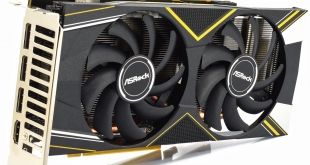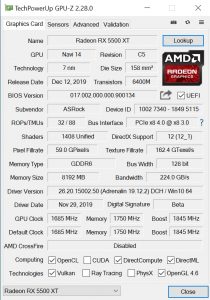
In the second of our launch day reviews for AMD's 5500 XT, we assess the ASRock Challenger 8GB OC Edition. It has taken some time for 5500 XT cards to come to market, with AMD's initial announcement made over two months ago, but they are finally here and today we see how this card compares to the likes of Nvidia's GTX 1650 SUPER, which itself only launched last month.
The first thing to note is that this review is concerned with ASRock's RX 5500 XT 8GB. 5500 XT is available in both 4GB and 8GB models (the only difference is the VRAM capacity), so if you want to see our review of a 4GB card, head over to the Sapphire Pulse HERE.
Secondly, AMD disclosed pricing to us yesterday, with the 4GB model retailing for £159.99 here in the UK, while the 8GB model is £20 more expensive at £179.99. While that means the 4GB model is going head-to-head with 1650 SUPER in the ~£150 market segment, the situation is a bit difference for the 8GB card. In fact, with GTX 1660 prices dropping since the arrival of the 1660 SUPER, cards are now available for as little as £180.
The last point to note in this introduction is how RX 5500 XT fits in with the rest of the RX 5500 series. When AMD made the initial announcement back in October, core spec was announced for the RX 5500 ‘series', but the 5500 XT was not explicitly mentioned. As it transpires, both the RX 5500 and RX 5500 XT use the exact same GPU, with the same core count. The primary differences are that RX 5500 (non-XT) has slightly lower clocks, is only available as a 4GB model, and is only available to OEMs. RX 5500 XT is available as a standalone part, so unless you want to buy a pre-built system, you can forget about the non-XT version of the 5500.
| GPU | RX 5500 XT | RX 5700 | RX 5700 XT | RX Vega 56 | RX Vega 64 | |
| Architecture | Navi | Navi | Navi | Vega 10 | Vega 10 | |
| Manufacturing Process | 7nm | 7nm | 7nm | 14nm | 14nm | |
| Transistor Count | 6.4 billion | 10.3 billion | 10.3 billion | 12.5 billion | 12.5 billion | |
| Die Size | 158mm² | 251mm² | 251mm² | 486mm² | 495mm² | |
| Compute Units | 22 | 36 | 40 | 56 | 64 | |
| Stream Processors | 1408 | 2304 | 2560 | 3584 | 4096 | |
| Base GPU Clock | n/a | Up to 1465MHz | Up to 1605MHz | 1156 MHz | 1274 MHz | |
| Game GPU Clock | Up to 1717MHz | Up to 1625MHz | Up to 1755MHz | n/a | n/a | |
| Boost GPU Clock | Up to 1845MHz | Up to 1725MHz | Up to 1905MHz | 1471 MHz | 1546 MHz | |
| Peak SP Performance | Up to 5.20 TFLOPS | Up to 7.95 TFLOPS | Up to 9.75 TFLOPS | Up to 10.5 TFLOPS | Up to 12.7 TFLOPS | |
| Peak Half Precision Performance | Up to 10.4 TFLOPS | Up to 15.9 TFLOPS | Up to 19.5 TFLOPS | Up to 21.0 TFLOPS | Up to 25.3 TFLOPS | |
| Peak Texture Fill-Rate | Up to 162.4 GT/s | Up to 248.4 GT/s | Up to 304.8 GT/s | Up to 330.0 GT/s | Up to 395.8 GT/s | |
| ROPs | 32 | 64 | 64 | 64 | 64 | |
| Peak Pixel Fill-Rate | Up to 59.0 GP/s | Up to 110.4 GP/s | Up to 121.9 GP/s | Up to 94.0 GP/s | Up to 98.9 GP/s | |
| Memory | 4/8GB GDDR6 | 8GB GDDR6 | 8GB GDDR6 | 8GB HBM | 8GB HBM | |
| Memory Bandwidth | 224 GB/s | 448 GB/s | 448 GB/s | 410 GB/s | 483.8 GB/s | |
| Memory Interface | 128-bit | 256-bit | 256-bit | 2048-bit | 2048-bit | |
| Board Power | 130W | 185W | 225W | 210W | 295W | |
With that in mind, GPU specs for the RX 5500 XT have therefore been online for two months, so nothing new is revealed to us. Built on the same Navi architecture as the RX 5700 and RX 5700 XT, and fabbed on TSMC's 7nm process, the RX 5500 XT consists of 22 Compute Units (CUs) and 1408 Stream Processors.
The same 14Gbps GDDR6 memory has also been brought down from the RX 5700 series, with 4GB or 8GB models. The 5500 XT however has a narrower, 128-bit memory interface, meaning total memory bandwidth is 224 GB/s, or half that of its pricier brethren.
As for clock speeds, the ASRock card here follows the reference specification with a 1845MHz boost clock. Total board power is rated at 130W, or 30W above GTX 1650 SUPER.
 KitGuru KitGuru.net – Tech News | Hardware News | Hardware Reviews | IOS | Mobile | Gaming | Graphics Cards
KitGuru KitGuru.net – Tech News | Hardware News | Hardware Reviews | IOS | Mobile | Gaming | Graphics Cards



